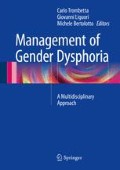Abstract
To define what key literature and source of knowledge may offer epidemiologic considerations on a human condition such as gender dysphoria and transsexualism, it might be useful to recall that etiologic epidemiology is the scientific observation of human beings for the purpose of discovering a cause of a disease and that clinical epidemiology is the study of determinants and effects of clinical decisions. In the search for both causes and effects of human conditions, the first step must be a flawless and stable definition of the condition. Once such a definition has been accepted, variants are recognized – eventually determining mutually exclusive categories – and then used for a relatively long time and in many geographic populations, and epidemiologic measures can be estimated including measures of frequency, measures of association, and measures of impact.
Access this chapter
Tax calculation will be finalised at checkout
Purchases are for personal use only
References
Rothman K (1986) Modern epidemiology. Little Brown, Boston
Cohen K et al Psychological characteristics and sexuality of natal males with gender dysphoria
WHO Library (1975) International statistical classification of diseases and related health problems. 9th revision, Geneva
American Psychiatric Association (1980) Diagnostic and statistical manual of mental disorders (third edition, DSM-III). American Psychiatric Association, Washington, DC
WHO Library (1980) International statistical classification of diseases and related health problems. 10th revision, Geneva
American Psychiatric Association (1994) Diagnostic and statistical manual of mental disorders (forth edition, DSM-IV). American Psychiatric Association, Washington, DC
American Psychiatric Association (2013) Diagnostic and statistical manual of mental disorders (fifth edition, DSM-5). American Psychiatric Association, Washington, DC
Dreger A Why gender dysphoria should no longer be considered a medical disorder. In: Pacific Standard Magazine. http://www.psmag.com/navigation/health-and-behavior/take-gender-identity-disorder-dsm-68308/. 18 Oct 2013
Benjamin H (1966) The transsexual phenomenon. Julian Press, New York
Socarides CW (1978–1979) Transsexualism and psychosis. Int J Psychoanal Psychother 7:373–384
Rey JH, Coppen AJ (1959) Distribution of androgyny in mental patients. Br Med J 26(2):1445–1447
World Professional Association for Transgender Health (2011) Standards of care for the health of transsexual, transgender and gender non-conforming people, 7th Version. http://www.wpath.org
Heylens G, Elaut E, Kreukels BPC, Paap MSC, Cerwenka S, Richter-Appelt H, Cohen Kettenis PT, Haraldsen I, De Cuypere G (2013) Psychiatric characteristics in transsexual individuals: multicentre study in four European Countries. Br J Psychiatry. doi:10.1192/bjp.bp.112.121954
Parkinson J (2014) Gender dysphoria in Asperger’s syndrome: a caution. Australas Psychiatry 22:84–85
Tateno M, Ikeda H, Saito T (2011) Gender dysphoria in pervasive developmental disorders. Seishin Shinkeigaku Zasshi 113:1173–1183
Lawrence A, Zucker K (2012) Gender identity disorders. In: Hersen M, Beidel D (eds) Adult psychopathology and diagnosis, 6th edn. Wiley, London, pp 601–635
Murad M, Elamin M, Garcia M, Mullan R, Murad A, Erwin P et al (2010) Hormonal therapy and sex reassignment: a systematic review and meta-analysis of quality of life and psychosocial outcomes. Clin Endocrinol (Oxf) 72:214–231
Dhejne C, Lichtenstein P, Boman M, Johansson ALV, Långström N et al (2011) Long-term follow-up of transsexual persons undergoing sex reassignment surgery: cohort study in Sweden. PLoS One 6(2):e16885. doi:10.1371/journal.pone.0016885
Asscheman H, Giltay EJ, Megens JA, de Ronde WP, van Trotsenburg MA, Gooren LJ (2011) A long-term follow-up study of mortality in transsexuals receiving treatment with cross-sex hormones. Eur J Endocrinol 164:635–642
Gooren LJ, Giltay EJ, Bunck MC (2008) Long-term treatment of transsexuals with cross-sex hormones: extensive personal experience. J Clin Endocrinol Metab 93:19–25
BMJ Best Practice reports. http://bestpractice.bmj.com/bestpractice/monograph/992/basics/epidemiology.html. 2014
Wilson P, Sharp C, Carr S (1999) The prevalence of gender dysphoria in Scotland: a primary care study. Br J Gen Pract 49:991–992
Gender Identity Research and Education Society. The number of gender variant people in the UK – update 2011. http://www.gires.org.uk
Okabe N, Sato T, Matsumoto Y, Ido Y, Terada S, Kuroda S (2008) Clinical characteristics of patients with gender identity disorder at a Japanese gender identity disorder clinic. Psychiatry Res 157:315–318
Vujovic S, Popovic S, Sbutega-Milosevic G, Djordjevic M, Gooren L (2009) Transsexualism in Serbia: a twenty-year follow-up study. J Sex Med 6:1018–1023
Veale JF (2008) Prevalence of transsexualism among New Zealand passport holders. Aust N Z J Psychiatry 42:887–889
De Cuypere G, Van Hemelrijck M, Michel A, Carael B, Heylens G, Rubens R, Hoebeke P, Monstrey S (2007) Prevalence and demography of transsexualism in Belgium. Eur Psychiatry 22:137–141
Conron KJ, Scott G, Stowell GS, Landers SJ (2012) Transgender health in Massachusetts: results from a household probability sample of adults. Am J Public Health 102:118–122
Heckathorn DD (1997) Respondent-driven sampling: a new approach to the study of hidden populations. Soc Probl 44:174–199
Author information
Authors and Affiliations
Corresponding author
Editor information
Editors and Affiliations
Rights and permissions
Copyright information
© 2015 Springer-Verlag Italia
About this chapter
Cite this chapter
Barbone, F. (2015). Epidemiologic Considerations on Transsexualism. In: Trombetta, C., Liguori, G., Bertolotto, M. (eds) Management of Gender Dysphoria. Springer, Milano. https://doi.org/10.1007/978-88-470-5696-1_5
Download citation
DOI: https://doi.org/10.1007/978-88-470-5696-1_5
Published:
Publisher Name: Springer, Milano
Print ISBN: 978-88-470-5695-4
Online ISBN: 978-88-470-5696-1
eBook Packages: MedicineMedicine (R0)

